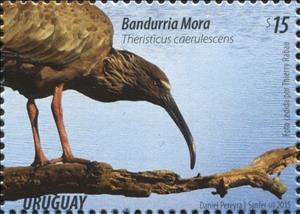Stamp: Plumbeous Ibis (Theristicus caerulescens) (Uruguay 2015)
Plumbeous Ibis (Theristicus caerulescens) (Uruguay 2015)
05 June (Uruguay ) within release Wetlands for Our future goes into circulation Stamp Plumbeous Ibis (Theristicus caerulescens) face value 15 Uruguayan peso
| Stamp Plumbeous Ibis (Theristicus caerulescens) in catalogues | |
|---|---|
| WADP Numbering System - WNS: | WAD:UY021.15 |
Stamp is horizontal format.
Also in the issue Wetlands for Our future:
- Stamp - Scarlet-headed Blackbird (Amblyramphus holosericeus) face value 15;
- Stamp - Black Skimmer (Rynchops niger intercedens) face value 15;
- Stamp - Chilean Flamingo (Phoenicopterus chilensis) face value 15;
- Stamp - Snowy Egret (Egretta thula) face value 15;
- Stamp - Plumbeous Ibis (Theristicus caerulescens) face value 15;
- Stamp - Capybara (Hydrochoerus hydrochaeris) face value 15;
- Stamp - Saffron-cowled Blackbird (Xanthopsar flavus) face value 15;
- Stamp - Greem Snake (Philodryas aestiva) face value 15;
- Stamp - Neohelice crab (Neohelice granulata) face value 15;
- Stamp - Melanophryniscus montevidensis face value 15;
- Mini Sheet - Wetlands for Our future face value ;
- Stamp - Scarlet-headed Blackbird (Amblyramphus holosericeus) face value 15;
- Stamp - Black Skimmer (Rynchops niger intercedens) face value 15;
- Stamp - Chilean Flamingo (Phoenicopterus chilensis) face value 15;
- Stamp - Snowy Egret (Egretta thula) face value 15;
- Stamp - Plumbeous Ibis (Theristicus caerulescens) face value 15;
- Stamp - Capybara (Hydrochoerus hydrochaeris) face value 15;
- Stamp - Saffron-cowled Blackbird (Xanthopsar flavus) face value 15;
- Stamp - Common Green Racer (Phylodryas aestiva) face value 15;
- Stamp - Grapsid Crab (Neohelice granulatus) face value 15;
- Stamp - Montevideo Red-belly Toad (Melanophryniscus montevidensis) face value 15;
- Souvenir Sheet - Issued In A Sheet Forming Composite Design face value 10*15;
Stamp Plumbeous Ibis (Theristicus caerulescens) it reflects the thematic directions:
Animals are multicellular, eukaryotic organisms of the kingdom Animalia (also called Metazoa). All animals are motile, meaning they can move spontaneously and independently, at some point in their lives. Their body plan eventually becomes fixed as they develop, although some undergo a process of metamorphosis later on in their lives. All animals are heterotrophs: they must ingest other organisms or their products for sustenance.
Birds (Aves), a subgroup of Reptiles, are the last living examples of Dinosaurs. They are a group of endothermic vertebrates, characterised by feathers, toothless beaked jaws, the laying of hard-shelled eggs, a high metabolic rate, a four-chambered heart, and a strong yet lightweight skeleton. Birds live worldwide and range in size from the 5 cm (2 in) bee hummingbird to the 2.75 m (9 ft) ostrich. They rank as the class of tetrapods with the most living species, at approximately ten thousand, with more than half of these being passerines, sometimes known as perching birds. Birds are the closest living relatives of crocodilians.


